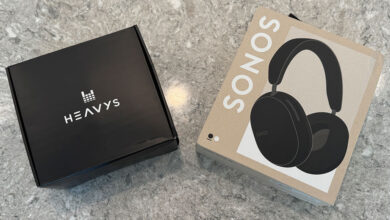Apple Vision Pro Impressions: One Week Later

No one alive today witnessed the creation of groundbreaking technologies like the printing press, telegraph, and telephone — all of which drastically transformed communication. In the past century, few innovations have reached such monumental levels. In this context, the Apple Vision Pro stands out as a distinct combination of hardware and software, offering a unique experience that could endure over time.
I get it — the $3,499 price of the Apple Vision Pro is quite steep and out of reach for most people, no matter how innovative and practical it seems. Even though I’ve been using it for a week and can’t stop, it’s not yet a must-have item for everyone, like the iPhone and iPad were. However, it offers a crucial early look at the future, which could take a decade or more to become widespread. Given this, the Apple Vision Pro is already a remarkable achievement.
Factors like weight, usability, and fit are highly personal, and it’s impossible to account for every potential user. I admit that many people unfamiliar with the Vision Pro headset — possibly more than Apple would care to admit — might find it heavy or uncomfortable. For me, it fits well, and its weight, which is lighter than the Meta Quest 3, hasn’t been a problem.
Although the Apple Vision Pro’s launch went smoothly, it can’t truly be considered a success until more native apps are available. This will be a key test for Apple if the company hopes to achieve its goals with the Vision Pro.
Diverse Opinions, Sometimes Contradictory
After using the Vision Pro for about a week, I have a range of opinions. While some of my analyst colleagues may disagree, I tend to take a more optimistic view on the Vision Pro’s potential.
To put it plainly, the Vision Pro is Apple’s first device designed for spatial computing. When Apple introduced the Vision Pro last June, it coined the term “spatial computing” as a marketing phrase, and after spending time with it, I now understand why.
Despite its impressive technology and design (which easily justifies the high price tag), augmented reality glasses have always been limited by physics and the availability of current components. Today, the Vision Pro platform, in its early stages, holds immense potential, but it will take time before the right use cases catch on with the wider public.
The R1 chip, combined with external cameras and sensors, maps the user’s environment in 3D within the display. Sometimes, it feels like you’re not wearing a headset at all, but the illusion fades if the room is too dark. Interestingly, the quieter the space, the more noticeable the background noise. Yet this is part of what makes the product so immersive.
Virtual reality headset enthusiasts know about the “screen door” effect, which occurs when display resolution isn’t high enough to prevent visible pixels when your eyes get close to the screen.
To address this, the Vision Pro balances pixel density to reduce the effect. Because of its high pixel density, windows, text, and user interfaces appear as sharp as they do on an iPhone. It’s a striking experience, almost as though you’re looking at two small monitors inside the headset, offering an immersive visionOS experience.
Not Full Peripheral Vision
While wearing the Vision Pro gives an amazing sense of immersion, users will always notice that the room appears brighter when the headset is removed. The immersive settings I used in my dimly lit office sometimes made everything appear blurry. Better lighting improved this situation, and many Vision Pro users may want to reconsider their home office lighting if they plan to use the device regularly.
Additionally, the displays don’t cover the entire field of view, leaving a black border and lacking full peripheral vision. Currently, no headset can replicate complete peripheral vision due to technological limits.
When something unusual appears in our line of sight, our brains are quick to focus on it and ignore everything else. For example, even though your nose is always visible, your brain works to block it out.
A Powerful Machine
The Vision Pro’s processing power enables it to run demanding applications. The M2 chip likely won’t be a bottleneck for most apps for a while, as developers are either creating native apps or porting iPad apps.
If Apple had allowed the Vision Pro to run Mac software, the computing environment could have become more complicated. So, Apple wisely restricted it to running iOS and iPadOS apps, which offers performance and battery life benefits.
Although my testing hasn’t been exhaustive, I haven’t encountered any apps that push the M2 to its limits. I was pleased to see several of my favorite iPadOS apps, such as Xfinity Streaming, OneCast (for Xbox streaming), and Plex, work smoothly.
While VisionOS isn’t perfect — it did crash a couple of times — these issues should improve with future software updates. Below is a short video showing some of the interesting demos I experienced in just a few hours of using the Vision Pro.
User Interface: A Major Achievement
If I had to highlight one standout feature of the Vision Pro, it would be its user interface.
First, VisionOS shares many similarities with iOS and iPadOS, making the learning curve much less steep. Additionally, the ability to select a button simply by looking at it and pinching your fingers is a breakthrough in usability, similar to the impact of using a mouse or touchpad on a desktop. It’s not flawless, but it’s impressively functional and will continue to improve.
Future Versions of Vision Pro
There are rumors that Apple plans to wait until 2026 to release the Apple Vision Pro 2 or a non-Pro version. While that may not be a major concern for an initial release of a new platform, it’s still a long time to be restricted to the M2 chip, especially with more demanding apps likely to emerge.
Developers are always looking for more power, and I don’t think Vision Pro will be an exception to this trend.
In this context, Qualcomm may have an advantage with its new Snapdragon XR1, which could offer comparable performance at a lower price, potentially appearing in less expensive headsets than the Vision Pro.
A Limitless Platform
From a platform perspective, Apple Vision Pro and visionOS have nearly limitless possibilities. Now that the visionOS beta is officially live, it’s easy to predict where the technology will be in a month, but longer-term predictions are more difficult.
Vision Pro marks Apple’s first completely new computer platform since the iPad. Although the hardware is only available in the U.S. for now, things will quickly change as it becomes available to a wider audience. The insights Apple gains from observing daily consumer use of the Vision Pro will surely shape future versions of visionOS.
Augmented Reality’s Mainstream Future
Most Apple products aren’t the first of their kind, but the Vision Pro is. It’s not a “fast follower” device, as no other product like it exists on the market.
Although Apple often uses the term “spatial computing” in its marketing, it’s not just a buzzword; it accurately describes the combination of virtual reality and mixed reality. This also reflects Apple’s belief that augmented reality (AR) will eventually capture the mainstream, offering practical and engaging use cases.
It’s important to note that software must keep pace with this new era that the Vision Pro ushers in. With cutting-edge screen technology, hand and eye tracking, and passthrough features, developers have a field day ahead of them. Unlike previous hardware in this category, the Vision Pro isn’t limited by hardware constraints.
A New Era of Computing
The spatial computing capabilities of the Vision Pro represent a groundbreaking leap in human-computer interaction. By seamlessly integrating digital content with our physical environment, it transforms how we engage with and perceive information.
No longer confined to traditional screens, users can now immerse themselves in a dynamic, interactive environment where the digital and physical worlds converge. This shift not only boosts productivity and efficiency but also opens up new possibilities for creativity and innovation.
In essence, the Vision Pro’s spatial computing sets the stage for a new era in computing, where the lines between the virtual and real worlds blur, and the digital realm becomes a core part of our everyday lives. As this technology evolves, it will have far-reaching impacts on fields like education, healthcare, entertainment, and beyond.
Ultimately, the Vision Pro’s spatial computing potential could revolutionize computing, unlocking vast possibilities and changing how we work, learn, and play.
Though the Apple Vision Pro is still in its first version, it may one day be considered as significant as innovations like the printing press and telephone. It will be fascinating to see where Apple takes this technology next.




